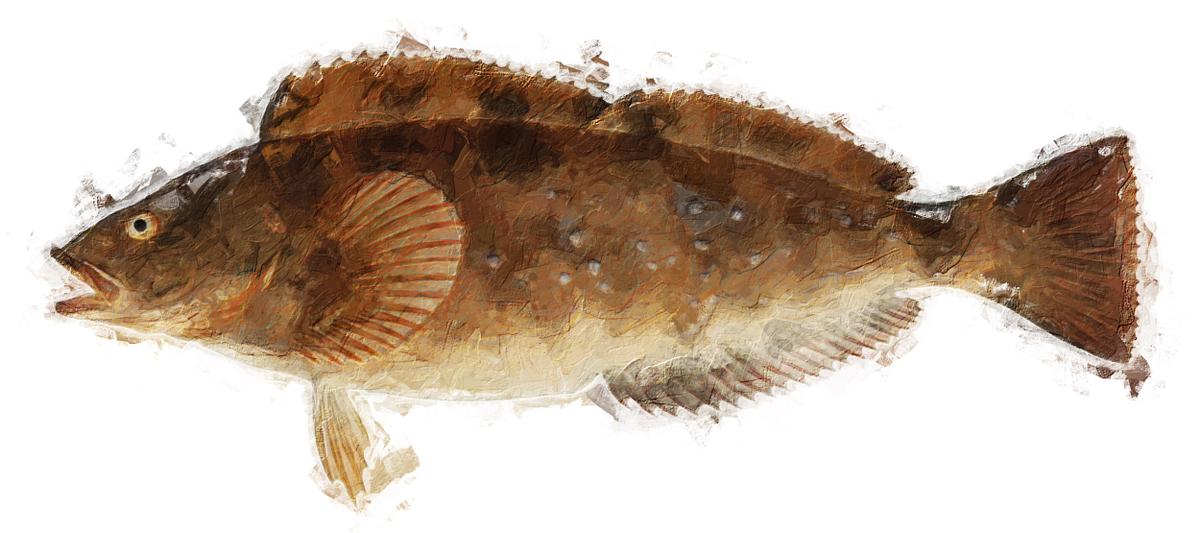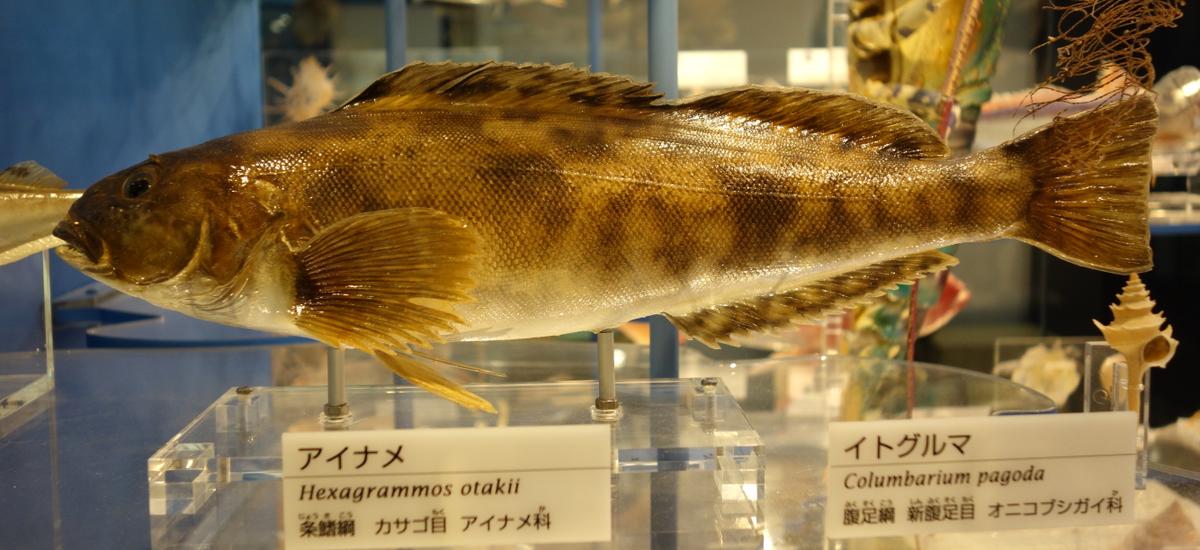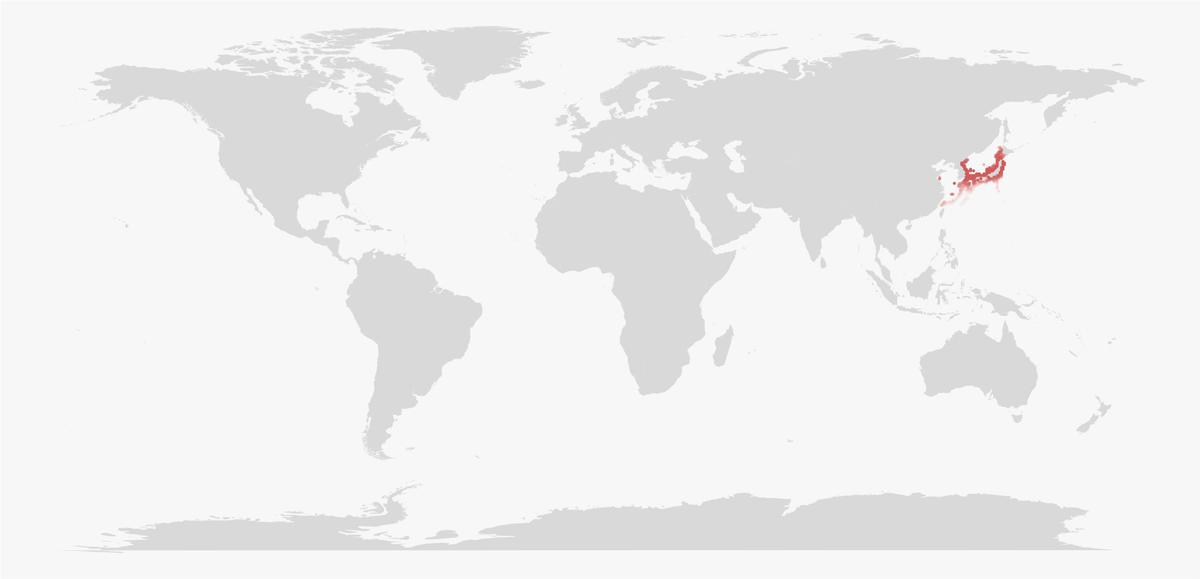Ainame Sushi
Fat Greenling

What is Ainame (Fat Greenling)?
The term ainame is predominantly used in Japanese for the fat greenling (鮎魚女、鮎並、愛魚女). In addition, the name also refers to other fresh belonging to the family of greenlings (ainame-ka, アイナメ科). Ainame is a popular fish in Japan, which prefers low-salt sea regions and is widely distributed along the coast of Japan. In addition to its use for sushi and sashimi, it is also an ingredient in many other dishes of Japanese cuisine.
Ainame as Ingredient for Sushi or Sashimi
The meat of the ainame is white, has a slightly sweet mild, yet aromatic flavor. The meat owes its strikingly light color to its high fat content. The texture is firm and elastic, but not tough. Fresh fish is preferred for the preparation of sashimi, but is also well suited for the preparation of ainame nigiri. The skin is delicious and fatty, which is why flamed (aburi, 炙り) or blanched ainame is also an appealing alternative for sushi or sashimi. This is done by either flaming the skin crisp with a blowtorch or pouring hot water over (kawashimo zukuri, 皮霜造り) it while leaving the rest of the meat raw.
Best Season
The taste is quite stable throughout the year, with the best season being from spring to summer, when the fish are more fatty and aromatic. Top specimens trade at remarkably high prices at this time of year.
Ainame in Japan
Looking at the Japanese kanji characters of ainame (鮎並) and ayu (鮎), it is noticeable that the kanji for ainame contain the character of ayu. It is commonly said that this is due to the fact that ainame males protect their brood as vigorously as an ayu. Now and then one comes across the claim that the character is a reference to the fact that an adult ainame resembles an ayu. However, even at a quick glance it can be seen that these fish have very little in common.
Characteristics & Ecology of Ainame (Fat Greenling)
Ainame prefers rocky coastal areas, shallow water below the tidal zone, occasionally also artificial reefs if covered by algae or seaweed. The distribution area extends along various parts of Japan except the Nansei Islands to the Korean Peninsula, the Yellow Sea coasts and southern Sakhalin. They usually reach a length of about 57 centimeters and weigh about 5 pounds. They are usually found on rough soils at depths of 140 to 155 meters. Ainame are a nocturnal species that lives territorially in rocky coastal areas. Their diet consists mainly of smaller fish, snails, mollusks and crustaceans. They have a certain importance for Japanese commercial fishing.

Image: Daderot
The spawning season is from late autumn to winter. In the colder waters of Hokkaido it starts already in September and ends in November. At this time of year the scales of the male take on a golden color, which is called wedding color (koninshoku、婚姻色、こんいんしょく). During this time, the males migrate into shallower water and form precincts there, in which they guard and care for the eggs fastened at small rocks. Although the males are responsible for the brood care, it was observed occasionally that they partially eat the carefully maintained eggs. The reason for this cannibalism is not yet conclusively clarified by science [Munehara & Miura, 1995].
Economy
In the market mainly individuals with a length of 30 to 40 cm can be found, occasionally they reach a size of up to 60 cm. The economic importance is low, in Japan a commercial breeding in aquacultures takes place sporadically. The most common fishing methods include by-catch in trawls, gillnets or pots. Furthermore, ainame is a popular catch for sport fishing.
The economic importance in relation to large-scale fisheries is so small that the Food and Agriculture Organization of the United Nations (FAO) does not explicitly include ainame (lat. Hexagrammos otakii) in its statistics.
Beast Season for Ainame
Video about Ainame
External video embedded from youTube.com: 魚屋の森さん. 【豪華】この時期だからこそ手に入る?高級魚「アイナメ」と日本酒「獺祭」で最高級の酒蒸しを頂きます!
Distribution Area of Ainame

Source: Kaschner, K., Kesner-Reyes, K., Garilao, C., Segschneider, J., Rius-Barile, J. Rees, T., & Froese, R. (2019, October). AquaMaps: Predicted range maps for aquatic species. Retrieved from https://www.aquamaps.org. Scarponi, P., G. Coro, and P. Pagano. A collection of Aquamaps native layers in NetCDF format. Data in brief 17 (2018): 292-296.
Warnings Regarding Ainame Sushi or Sashimi
- PARASITES: The meat, especially that of wild-caught specimens, may be infested with parasites that cause infectious diseases. Infection can be avoided if the raw meat has been adequately frozen. Pickling and soaking in salt or vinegar solution is not sufficient to eliminate the parasites. If the product has been farmed, only raw unprocessed seafood from production facilities whose products are approved for raw consumption should be consumed. [Williams, 1994]
Species of Ainame
The following species are regarded as authentic. Either historically, according to the area of distribution or according to the common practice in today's gastronomy:
Japanese Name | Common Names, Scientific Name |
|---|---|
ainame, aburame アイナメ、アブラメ 愛魚女、鮎並、鮎魚女 | fat greenling Hexagrammos otakii family: Hexagrammidae |
The following species can be considered subsitutes. Either on the basis of genetic relationship or because they are similar in taste or appearance:
Japanese Name | Common Names, Scientific Name |
|---|---|
aburakko, usagiainame アブラッコ、ウサギアイナメ | rock greenling Hexagrammos lagocephalus family: Hexagrammidae |
ezoainame エゾアイナメ | whitespotted greenling Hexagrammos stelleri family: Hexagrammidae |
kerupugurinringu ケルプグリンリング | kelp greenling Hexagrammos decagrammus family: Hexagrammidae |
kujime クジメ | Spotty-bellied greenling Hexagrammos agrammus family: Hexagrammidae |
sujiainame スジアイナメ | masked greenling Hexagrammos octogrammus family: Hexagrammidae |
References & Further Reading
- [Froese & Daniel, 2019]: Rainer Froese, Pauly Daniel. FishBase. The Leibniz Institute of Marine Sciences at the University of Kiel, FishBase.org. 2019. https://www.fishbase.org. Retrieved online on December 24, 2020.
- [Fujiwara, 2013]: 藤原昌高. すし図鑑 (engl. Sushi Picture Book). Mainabi Shuppan (マイナビ出版). 2013.
- [Heiter, 2007]: Celeste Heiter. The Sushi Book. Things Asian Press. 2007.
- [Hosking, 2015]: Richard Hosking. A Dictionary of Japanese Food: Ingredients & Culture. Tuttle Publishing, North Clarendon. 2015.
- [Munehara & Miura, 1995]: Hiroyuki Munehara, Teisuke Miura. Non-intentional filial egg cannibalism by the guarding male of Hexagrammos otakii (Pisces: Hexagramidae). Journal of Ethology. Source.Volume 13 (191). Japan Ethological Society, Nagoya. 1995.
- [Munehara & Takenaka, 2000]: Munehara Hiroyuki, Takenaka Osamu. Microsatellite markers and multiple paternity in a paternal care fish, Hexagrammos otakii. Journal of Ethology. Source.Volume 18 (2). Japan Ehological Society and Springer-Verlag, Tokyo. 2000.
- [Williams, 1994]: Hartford Williams. Parasitic Worms Of Fish. CRC Press, Taylor & Francis Group, Boca Raton. 1994.